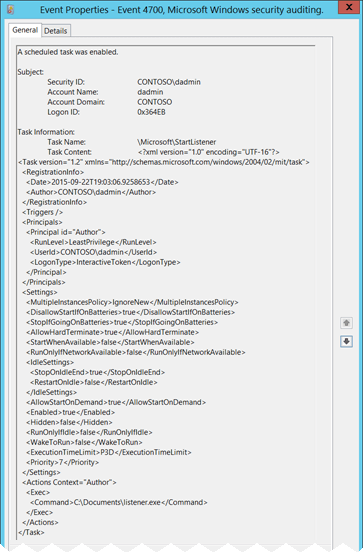4700(S): A scheduled task was enabled.

Subcategory: Audit Other Object Access Events
Event Description:
This event generates every time a scheduled task is enabled.
Note For recommendations, see Security Monitoring Recommendations for this event.
Event XML:
- <Event xmlns="http://schemas.microsoft.com/win/2004/08/events/event">
- <System>
<Provider Name="Microsoft-Windows-Security-Auditing" Guid="{54849625-5478-4994-A5BA-3E3B0328C30D}" />
<EventID>4700</EventID>
<Version>0</Version>
<Level>0</Level>
<Task>12804</Task>
<Opcode>0</Opcode>
<Keywords>0x8020000000000000</Keywords>
<TimeCreated SystemTime="2015-09-23T02:32:47.606423000Z" />
<EventRecordID>344861</EventRecordID>
<Correlation />
<Execution ProcessID="516" ThreadID="756" />
<Channel>Security</Channel>
<Computer>DC01.contoso.local</Computer>
<Security />
</System>
- <EventData>
<Data Name="SubjectUserSid">S-1-5-21-3457937927-2839227994-823803824-1104</Data>
<Data Name="SubjectUserName">dadmin</Data>
<Data Name="SubjectDomainName">CONTOSO</Data>
<Data Name="SubjectLogonId">0x364eb</Data>
<Data Name="TaskName">\\Microsoft\\StartListener</Data>
<Data Name="TaskContent"><?xml version="1.0" encoding="UTF-16"?> <Task version="1.2" xmlns="http://schemas.microsoft.com/windows/2004/02/mit/task"> <RegistrationInfo> <Date>2015-09-22T19:03:06.9258653</Date> <Author>CONTOSO\\dadmin</Author> </RegistrationInfo> <Triggers /> <Principals> <Principal id="Author"> <RunLevel>LeastPrivilege</RunLevel> <UserId>CONTOSO\\dadmin</UserId> <LogonType>InteractiveToken</LogonType> </Principal> </Principals> <Settings> <MultipleInstancesPolicy>IgnoreNew</MultipleInstancesPolicy> <DisallowStartIfOnBatteries>true</DisallowStartIfOnBatteries> <StopIfGoingOnBatteries>true</StopIfGoingOnBatteries> <AllowHardTerminate>true</AllowHardTerminate> <StartWhenAvailable>false</StartWhenAvailable> <RunOnlyIfNetworkAvailable>false</RunOnlyIfNetworkAvailable> <IdleSettings> <StopOnIdleEnd>true</StopOnIdleEnd> <RestartOnIdle>false</RestartOnIdle> </IdleSettings> <AllowStartOnDemand>true</AllowStartOnDemand> <Enabled>true</Enabled> <Hidden>false</Hidden> <RunOnlyIfIdle>false</RunOnlyIfIdle> <WakeToRun>false</WakeToRun> <ExecutionTimeLimit>P3D</ExecutionTimeLimit> <Priority>7</Priority> </Settings> <Actions Context="Author"> <Exec> <Command>C:\\Documents\\listener.exe</Command> </Exec> </Actions> </Task></Data>
</EventData>
</Event>
Note
Windows 10 Versions 1903 and above augments the event with these additional properties: Event Version 1. Event XML:
<Data Name="ClientProcessStartKey">5066549580796854</Data>
<Data Name="ClientProcessId">3932</Data>
<Data Name="ParentProcessId">5304</Data>
<Data Name="RpcCallClientLocality">0</Data>
<Data Name="FQDN">DESKTOP-Name</Data>
Required Server Roles: None.
Minimum OS Version: Windows Server 2008, Windows Vista.
Event Versions: 0.
Field Descriptions:
Subject:
- Security ID [Type = SID]: SID of account that requested the “enable scheduled task” operation. Event Viewer automatically tries to resolve SIDs and show the account name. If the SID cannot be resolved, you will see the source data in the event.
Note A security identifier (SID) is a unique value of variable length used to identify a trustee (security principal). Each account has a unique SID that is issued by an authority, such as an Active Directory domain controller, and stored in a security database. Each time a user logs on, the system retrieves the SID for that user from the database and places it in the access token for that user. The system uses the SID in the access token to identify the user in all subsequent interactions with Windows security. When a SID has been used as the unique identifier for a user or group, it cannot ever be used again to identify another user or group. For more information about SIDs, see Security identifiers.
Account Name [Type = UnicodeString]: the name of the account that requested the “enable scheduled task” operation.
Account Domain [Type = UnicodeString]: subject’s domain or computer name. Formats vary, and include the following:
Domain NETBIOS name example: CONTOSO
Lowercase full domain name: contoso.local
Uppercase full domain name: CONTOSO.LOCAL
For some well-known security principals, such as LOCAL SERVICE or ANONYMOUS LOGON, the value of this field is “NT AUTHORITY”.
For local user accounts, this field will contain the name of the computer or device that this account belongs to, for example: “Win81”.
Logon ID [Type = HexInt64]: hexadecimal value that can help you correlate this event with recent events that might contain the same Logon ID, for example, “4624: An account was successfully logged on.”
Task Information:
- Task Name [Type = UnicodeString]: enabled scheduled task name. The format of this value is “\task_path\task_name”, where task_path is a path in Microsoft Task Scheduler tree starting from “Task Scheduler Library” node:

- Task Content [Type = UnicodeString]: the XML of the enabled task. Here “XML Task Definition Format” you can read more about the XML format for scheduled tasks.
Security Monitoring Recommendations
For 4700(S): A scheduled task was enabled.
Important For this event, also see Appendix A: Security monitoring recommendations for many audit events.
- If a highly critical scheduled task exists on some computers, and for some reason it should never be enabled, monitor for 4700 events with the corresponding Task Name.